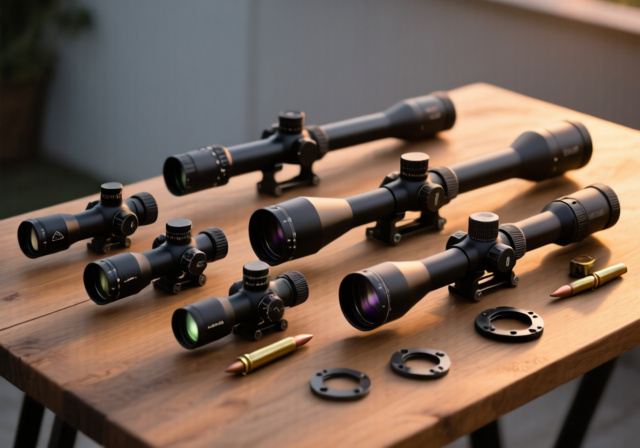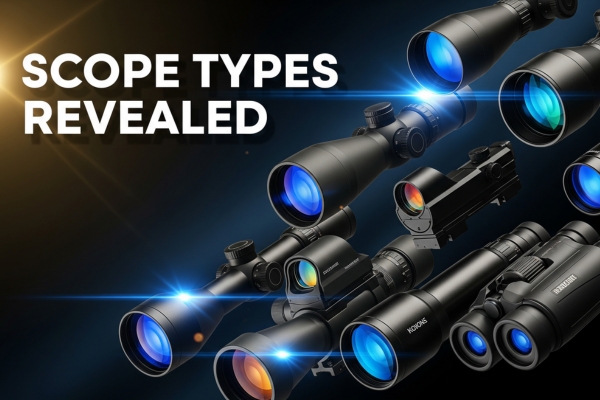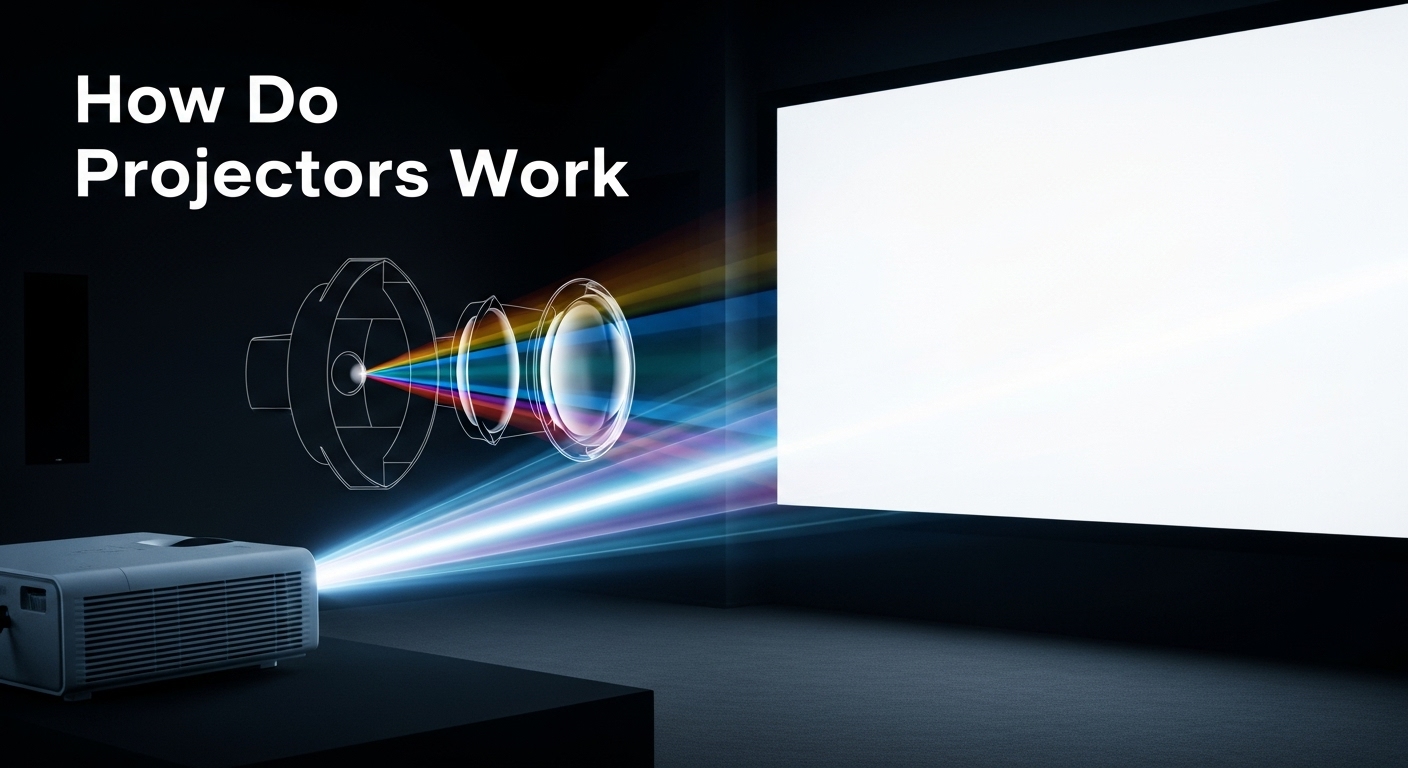



When I first started exploring optical instruments, I was overwhelmed by the sheer variety of scopes available. From precision rifle scopes to massive astronomical telescopes, each type serves a specific purpose and employs unique optical principles. Today, we’ll explore every major category of scope, helping you understand what makes each one special and when to use them.
Scopes are essentially optical instruments that magnify distant objects, making them appear larger and clearer to the human eye. The basic principle involves gathering light through lenses or mirrors and focusing it to create a magnified image. However, the specific design and application of each scope type varies dramatically based on its intended use.
In 2025, we have more scope options than ever before, with digital technology augmenting traditional optical designs. Whether you’re a hunter, astronomer, birdwatcher, or medical professional, understanding the different scope types will help you choose the right tool for your needs.
Rifle scopes are perhaps the most commonly discussed type of scope, designed specifically for accurate targeting at various distances. These optical devices mount directly onto firearms and provide magnified views of targets along with reticle systems for precise aiming.
Fixed power scopes offer a single magnification level, typically ranging from 2x to 20x. I’ve found these scopes excel in specific applications where the shooting distance remains relatively constant. Their simpler construction means fewer moving parts, resulting in exceptional durability and optical clarity. The lack of internal movement also makes them more reliable in extreme conditions.
Variable power scopes allow shooters to adjust magnification across a range, such as 3-9x or 4-16x. This versatility makes them incredibly popular among hunters and sport shooters who encounter targets at varying distances. The ability to zoom in and out provides tactical advantages in dynamic shooting scenarios.
Understanding FFP vs SFP scopes is crucial for serious shooters. FFP scopes place the reticle in front of the magnification lenses, causing it to scale with magnification changes. This maintains consistent subtension values for range estimation. SFP scopes position the reticle behind the magnification system, keeping it the same apparent size regardless of zoom level.
Prism scopes use a glass prism to focus the image rather than traditional lenses. These compact optics typically offer lower magnification (1x to 5x) but provide an etched reticle that remains visible even without battery power. They’re particularly useful for shooters with astigmatism who struggle with red dot sights.
Telescopes are specialized scopes designed primarily for astronomical observation, though they also serve terrestrial viewing purposes. These instruments gather far more light than the human eye, revealing celestial objects invisible to naked-eye observation.
Refractor telescopes use lenses to gather and focus light, similar to a camera lens or binoculars. The objective lens at the front collects light and brings it to focus at the eyepiece. These telescopes provide sharp, high-contrast images and require minimal maintenance since the optics are sealed inside the tube.
Reflector telescopes employ mirrors instead of lenses to collect and focus light. The primary mirror at the bottom of the tube reflects light to a secondary mirror, which then directs it to the eyepiece. This design allows for larger apertures at lower costs, making them popular among amateur astronomers seeking maximum light-gathering power.
Compound or catadioptric telescopes combine lenses and mirrors to create a compact, versatile design. Schmidt-Cassegrain and Maksutov-Cassegrain models fold the optical path, resulting in portable instruments with long focal lengths. These portable telescopes offer excellent versatility for both astronomical and terrestrial viewing.
Spotting scopes bridge the gap between binoculars and telescopes, offering high magnification in a portable package. These instruments typically provide 15x to 60x magnification and feature weatherproof construction for outdoor use.
When choosing between angled vs straight spotting scopes, consider your primary viewing scenarios. Angled eyepieces work better for extended observation sessions and when sharing the scope among users of different heights. Straight designs offer more intuitive target acquisition and work better for viewing from vehicles or hides.
Spotting scopes excel in various applications including birdwatching, wildlife observation, target shooting verification, and surveillance. Their rugged construction and powerful magnification make them indispensable tools for outdoor enthusiasts and professionals alike.
While technically not a single scope but a paired system, binoculars deserve mention as essential optical instruments. They provide stereoscopic vision, creating depth perception that single scopes cannot match. This three-dimensional view makes them ideal for tracking moving subjects and general observation.
Understanding binoculars vs telescopes helps determine which tool suits your needs. Binoculars offer wider fields of view and easier handheld use, while telescopes provide higher magnification and superior light-gathering for astronomical observation.
Microscopes represent the opposite end of the magnification spectrum, designed to observe tiny objects at extreme magnification levels. Compound microscopes use multiple lenses to achieve magnifications from 40x to 1000x or more, revealing cellular structures and microorganisms invisible to the naked eye.
Endoscopes are flexible or rigid tubes containing optical fibers or tiny cameras, allowing visual inspection of internal spaces. Medical endoscopes enable minimally invasive procedures, while industrial borescopes inspect engine cylinders, pipes, and other confined spaces. These specialized scopes have revolutionized both medicine and industrial maintenance.
Periscopes use mirrors or prisms to redirect the line of sight, allowing observation from concealed positions. Originally developed for submarines, modern periscopes incorporate advanced optics and digital imaging systems. Similar principles apply to tactical periscopes used by military and law enforcement personnel.
Rangefinder scopes combine magnification with distance measurement capabilities. Using laser technology or reticle-based estimation systems, these scopes provide both target visualization and precise range data. This dual functionality proves invaluable for long-range shooting, golf, and surveying applications.
Modern technology has introduced digital scopes that capture images electronically rather than through traditional optics alone. These devices offer features impossible with purely optical systems, including image recording, night vision capabilities, and ballistic calculators.
Thermal scopes detect heat signatures rather than visible light, revealing targets in complete darkness or through smoke and fog. Digital night vision scopes amplify available light electronically, providing clear images in low-light conditions without the green tint of traditional night vision.
Smart scopes integrate computers and sensors to calculate bullet drop, wind drift, and other ballistic factors automatically. Some models even prevent the rifle from firing until perfectly aligned with the target, virtually guaranteeing first-shot hits at extended ranges.
Selecting the appropriate scope depends on several critical factors. First, consider your primary application – hunting requires different features than astronomy or surveillance. Your budget also plays a crucial role, as quality optics represent significant investments.
For those new to scopes, I recommend starting with a clear understanding of your needs. Our rifle scope selection guide provides detailed guidance for firearm applications, while astronomical observers should consider their viewing locations and portability requirements.
Environmental conditions significantly impact scope selection. Marine environments demand waterproof construction and fog-resistant coatings. Desert use requires robust sealing against dust and sand. Cold weather operation needs materials and lubricants that maintain functionality at low temperatures.
Consider the learning curve associated with different scope types. Fixed magnification scopes offer simplicity for beginners, while variable power models provide versatility as skills develop. Complex reticle systems and advanced features may overwhelm new users but prove invaluable to experienced operators.
Regardless of type, all scopes require proper maintenance to maintain optimal performance. Regular cleaning of external lenses prevents dirt and debris from scratching delicate coatings. Use only appropriate cleaning solutions and microfiber cloths designed for optical surfaces.
Storage conditions affect scope longevity significantly. Humidity causes internal fogging and potential fungus growth in optical elements. Store scopes in dry environments with silica gel packets to absorb moisture. Avoid extreme temperature fluctuations that stress materials and coatings.
Different scope types have unique maintenance requirements. Telescope mirrors need periodic collimation to maintain alignment. Rifle scopes require checking mount tightness and zero retention. Digital scopes need battery maintenance and firmware updates. Understanding these specific needs ensures years of reliable service.
Scope technology continues advancing rapidly with innovations in materials, coatings, and digital integration. Graphene-based lens coatings promise unprecedented light transmission and durability. Adaptive optics borrowed from astronomy may soon appear in consumer scopes, automatically correcting for atmospheric distortion.
Augmented reality integration represents the next frontier in scope development. Future scopes may overlay digital information directly onto the optical image, providing real-time data about targets, environmental conditions, and ballistic solutions without breaking sight picture.
The world of scopes encompasses an incredible variety of optical instruments, each optimized for specific applications. From precision rifle scopes enabling long-range accuracy to powerful telescopes revealing distant galaxies, these tools extend human vision far beyond natural limitations.
Understanding the different types of scopes empowers you to select the right instrument for your needs. Whether you’re pursuing recreational activities, professional applications, or scientific research, there’s a scope designed specifically for your requirements.
As technology continues advancing, we can expect even more innovative scope designs that blur the lines between traditional categories. However, the fundamental purpose remains unchanged – helping us see more clearly and observe what would otherwise remain hidden from view.







